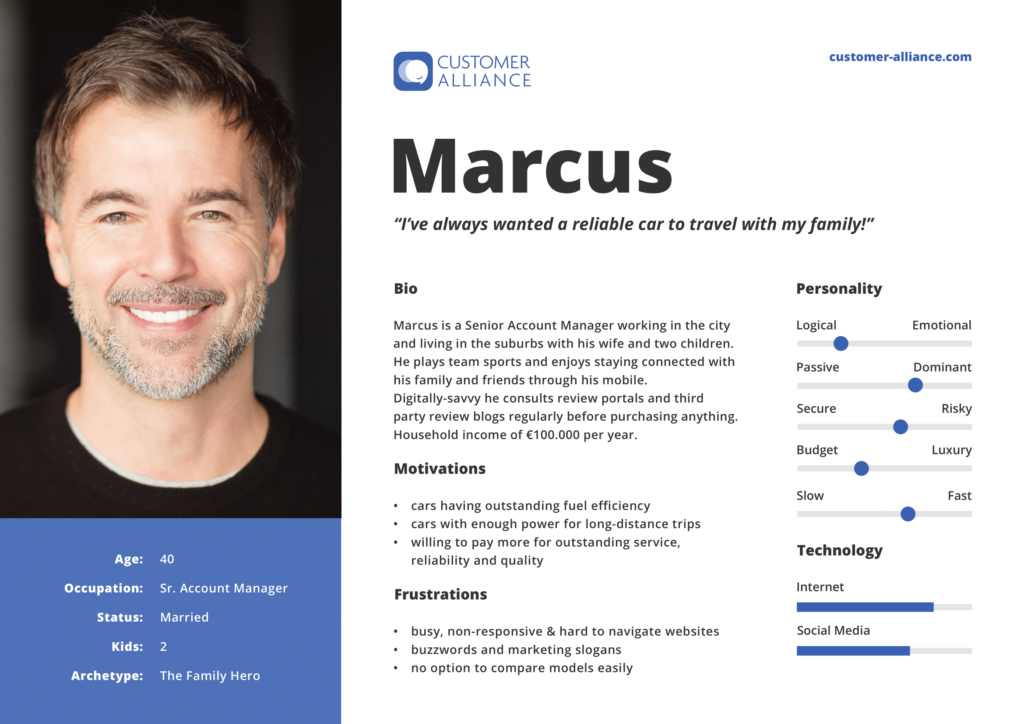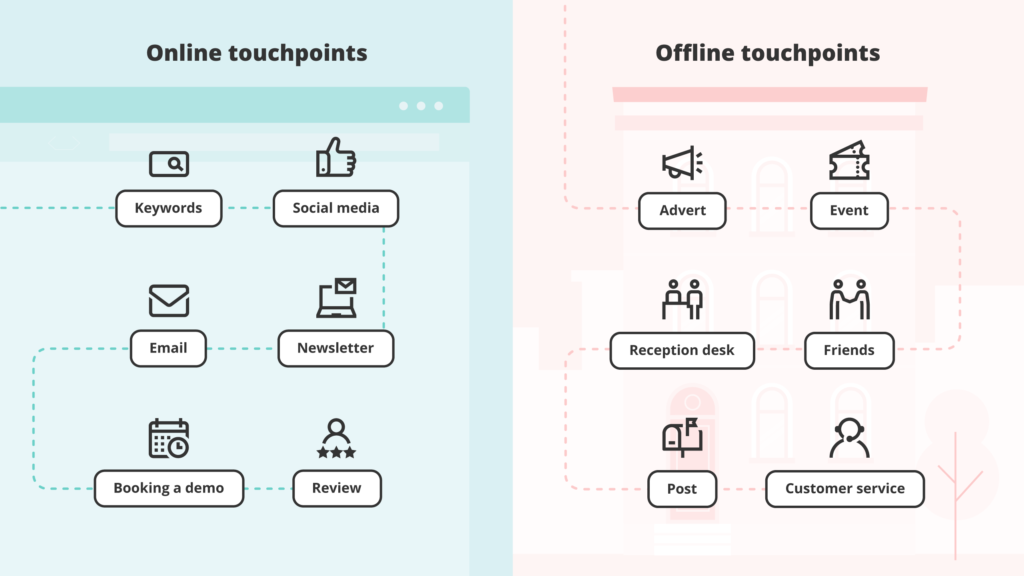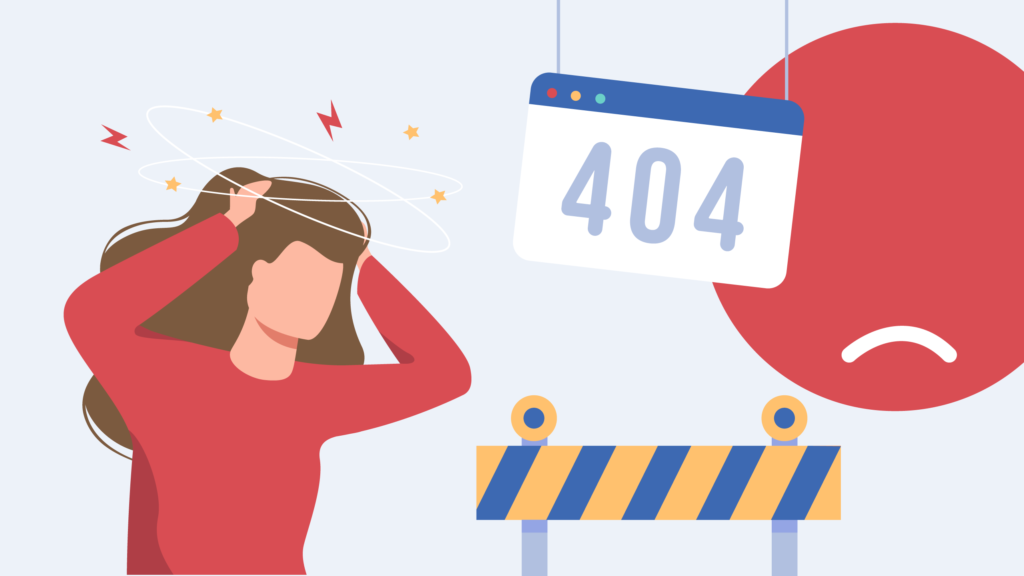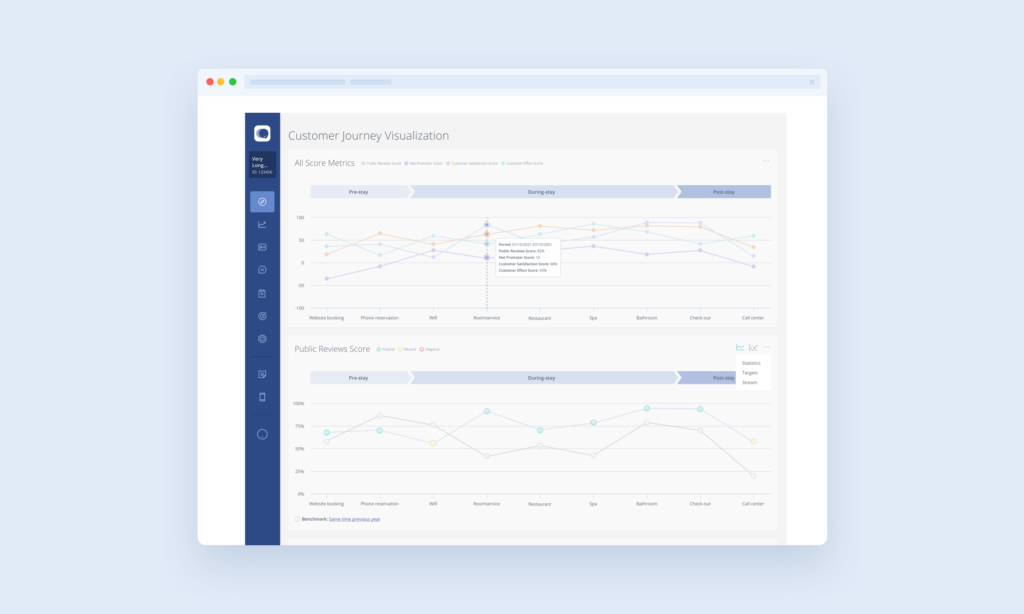Understanding your customer journey is key to the success of any business. When you can clearly see the steps your customer takes (and the feelings that go with them), you are in a much better position to make their experience a good one. But getting inside your customer’s mind isn’t always easy. That’s where customer journey mapping comes in!
The concept of customer journey mapping is not a new one, first introduced in 1998 by a British consulting company. Since then, the approach has grown and evolved to become one of the most widely used ways to understand customers across all kinds of industries – and for good reason.
Traditionally, customer or consumer journeys were fairly linear and often comprised just a few steps. For instance, it wasn’t unusual for seeing an advert on TV, going to a shop and making the purchase to be the only components of a customer journey.
But today, customer journeys tend to be far more complex, involving multiple different channels and technologies to reach the final destination. In addition, the route customers take has changed, going from a linear journey to a cyclical one with lots of back and forth.
The good news is that by plotting out these touchpoints on a customer journey map, you can understand your customers better. As a result, you can deliver outstanding experiences time and time again. Here is everything you need to know about customer journey mapping.
What is a customer journey map
[ca-form id=”194451″ align=”left” var1=”https://www.customer-alliance.com/wp-content/uploads/2021/11/customer-alliance-customer-journey-map-guide-download.pdf”]
To appreciate how powerful a customer journey map can be for your business, first you need a thorough understanding of what it entails. In short, a customer journey map is a visual representation of all the interactions a customer has with your brand.
Just as you might plot a route on a traditional map, it allows you to see a customer’s entire buying journey from A to B. While the journey will be different for every company, a customer journey map can detail everything from initial awareness of your business all the way through to brand advocacy. These steps are your customer journey touchpoints.
A customer journey map details not only how your customers move through each phase of the journey but also how they experience it. For example, any emotions they feel and any roadblocks they encounter.
For the best results, a customer journey map shouldn’t be limited to interactions with your company website or location. That is to say, it should include interactions across all different channels (both on and offline).
Why is customer journey mapping so important?
Truly understanding your customers is key to creating positive, memorable experiences that keep them coming back for more.
For instance, think of the last time you were really impressed with a product or service. Did you leave a glowing review online? Or perhaps you recommended it to a friend or colleague? Making your customer experience the best it can be helps turn happy customers into loyal ones. In other words, customers who will advocate for your brand.
Customer journey mapping is perhaps the most effective way to get the knowledge you need to make that happen. In short, it allows you to:
- Fully understand your customers, their goals and expectations
- Increase customer engagement by providing a personalised experience
- Identify and eliminate pain points and, as a result, make customer journeys smooth and stress-free
- Get rid of ineffective consumer journey touchpoints that may hurt your conversions
- Figure out what customers receive vs. what customers desire
- Assign ownership of touchpoints along the customer journey (and subsequently, increase the accountability of employees and departments)
That’s a lot of benefits that you don’t want to miss!
[ca-form id=”44600″ align=”right”]
Step-by-step: How to make a customer journey map
Creating your customer journey map is no small task, requiring extensive research and collaboration. But as we touched on above, it’s a hugely valuable project that will reap rewards for your business. To make things simpler, we’ve broken down the process into manageable steps for you to tackle one at a time.
Step 1: Create a customer persona
Firstly, if you already have a customer persona, congratulations! You have a solid head start in creating your customer journey map and can skip to Step 2. If not, don’t worry. Creating a customer persona isn’t too time-intensive and will benefit many other areas of your business.
No matter the size of your company or the industry you are in, a well-researched customer persona is an essential part of customer experience management. So what exactly is it, and how do you create one?
A customer or buyer persona is a semi-fictional character that represents your ideal customer, created using real customer insights and market research. As well as being used for customer journey mapping, your customer persona can inform your brand guidelines, target your marketing efforts, generate higher-quality leads and much, much more.

What you’ll need
To get the most accurate customer persona, you should use real voice of the customer data wherever possible. You can do this by:
- Going through your contact database to uncover trends and common words
- Conducting interviews with customers
- Talking to customer-facing employees to glean their insights
- Conducting surveys
- Evaluating support tickets and complaint emails to help identify pain points
- Mining information from social media and review platforms where your audience spends time
For more about these different tools and techniques, you can take a look at our Voice of the Customer guide.
It’s not unusual for companies to have more than one customer persona. If that’s the case for you, it’s best to start with the most familiar one. You can always go back to your other customer personas later and create maps specifically for them.
What to include in your customer persona
Customer persons will typically include the following:
- Demographic information like the customer’s age, gender, location, education, profession, family situation and income
- Personal background including hobbies and interests
- Professional information like the industry they work in, their job title and company size
- Motivations – what do they want to achieve? Why?
- Hesitations – what are their pain points? What do they want to avoid?
- Your offering and how it fits into their life. What problem can you solve for them? How can you help them reach their goals?
An example of a customer persona
To help you see what the finished product might look like, we’ve come up with a fictional customer persona for Marcus, who is in the market for a new set of wheels.

MARCUS
Personal Profile
- 40 years old
- Living in the suburbs and working in the city
- A Senior Account Manager at a telecoms company
- Living with his wife and two children, Marcus plays team sports and enjoys staying connected with his family and friends through his mobile phone
- Digitally-savvy, Marcus consults review portals and third-party review blogs regularly before buying
- He spends a lot of team browsing through social media, but less time contributing
- He is motivated by career progression and his social life
- His household income is € 100.000 per year
Motivations
- Marcus is looking for a new car model that offers outstanding fuel efficiency because he is commuting to work every day and enjoys travelling by car with this family
- The car needs enough power for long-distance trips and to drive his children and their friends around
- He is willing to pay more for outstanding service, reliability and quality
Frustrations
- Marcus prefers websites that are easy to navigate, responsive and simple to understand
- Less impressed by buzzwords and marketing slogans and responds better to everyday language
- Wants to compare models easily
- He did not enjoy the service of his last dealership
How can our brand help him?
- Engage with Marcus online and via social media
- Provide content that is easy to understand and addresses his needs
- Offer him a high level of quality and service
Now you’ve got your shiny new customer persona in hand, it’s time to move on to the next phase of your customer journey map.
Step 2: Identify customer touchpoints
A touchpoint is any interaction a customer has with your brand before, during and even after they make a purchase. While some touchpoints are more important than others, each one poses an opportunity to change the way the customer feels about your brand and ultimately make their journey better. So that’s why being clear on those touchpoints is key to customer experience management.
As mentioned above, today’s customer journeys usually cover multiple channels, so it’s important to think beyond the actions taken on your website.

To make things clearer, let’s take a closer look at the different kinds of consumer journey touchpoints you might include. This is by no means a comprehensive list but should give you a good idea of the kind of touchpoints to map.
Online touchpoints
- Receiving a welcome email
- Leaving a review
- A Google search for your keywords
- Following your brand on social media
- Signing up to your newsletter
- Booking a demo through a scheduling app
Offline touchpoints
- Making a phone call to customer service
- Telling a friend about your product or service
- Seeing an advert in print media or on TV
- Attending a brand event
- Checking in at a reception desk
- Receiving your product in the post
How to approach your customer journey touchpoints
[ca-form id=”194451″ align=”left” var1=”https://www.customer-alliance.com/wp-content/uploads/2021/11/customer-alliance-customer-journey-map-assets-download.pdf”]
Remember, there is no one-size-fits-all, and the touchpoints you identify will vary depending on the industry you are in. Similarly, some customer journey touchpoints may also have underlying pieces that you need to consider.
Let’s explore the example of our customer persona, Marcus, who is looking to buy a new car. One of his touchpoints will be visiting the dealership. Sounds simple enough, right? But what about the signage he uses to help him find the dealership or the car park he uses when he arrives? There’s also all his interactions inside the dealership to think about.
This may sound a little daunting at first. However, the best way to approach this task is to simply put yourself in your customer’s shoes! If it was you encountering your brand for the first time, how would you proceed? When you walk through the customer journey step-by-step, the touchpoints should become crystal clear.
Don’t worry at this stage about how your customer journey map looks. You may even find it easiest to write your customer journey touchpoints down by hand as you go. Sticky notes can also be really helpful to visualise your map while it’s still in draft form and allow you to move things around.
Step 3: Capture positive emotions and thoughts
Every action your customer takes along their journey is motivated by emotions. As a result, capturing these is one of the most valuable parts of your customer journey map.
To create a truly successful customer experience you should be provoking positive emotions and thoughts wherever possible. This is what will give you the edge over competitors, increase customer satisfaction and keep your customers coming back for more.
However important it may be, you may be wondering how you can accurately gauge how your customer feels – and it’s a good question! This is another part of the customer journey map where the feedback economy is your friend. In other words, use real data wherever you can.
Research methods
To clarify, some key qualitative journey research methods include:
- Contextual interviews
- Observational interviews
- Focus groups
- Mining community boards and forums
Quantitative methods can also be applied here, such as:
- Surveys and other voice of the customer tools
- Customer satisfaction metrics like CSAT and Net Promoter Score (NPS)
- Reporting from customer-facing staff
If you like, you can always start by using simple conventions like ‘happy’ or ‘positive’ in your customer journey map. You can always get more specific once you gather more information.
Step 4: Identify pain points and hesitations
This step may not be as enjoyable as the last but is equally important when creating your customer journey map. Just as your customer will experience positive feelings along their journey, there will also be times where they aren’t quite so happy.

To clarify, pain points and hesitations are issues that may negatively impact your customer experience. Examples could be:
- Being unable to carry out a certain action on your website, for instance creating a wishlist or comparing models
- Waiting too long to reach a customer service representative
- Reading bad reviews
- Receiving bad customer service from a member of staff
- Abandoning check out because it was too long-winded or asked for too much information
Why pain points matter
How do these pain points make your customers feel? While some pain points may make your customer journey a little more difficult or lengthy, some can be so severe that they prevent a customer from using your product or service.
That’s why it’s so important to spend time identifying your customer journey touchpoints in Step 2. This will help you better identify where those negative emotions come into play.
Again, you can use existing resources or collect data here to get better insight into the roadblocks in your specific customer journey and the negative emotions they create. This will help you really nail down your customer requirements.
Step 5: Clarify ownership
While it’s true that your customer is at the heart of your map, each touchpoint requires input from different people to make it happen. For instance, your customer might have seen a Facebook ad created by the marketing team. Or they may have asked for information from customer service and made an order through a sales executive.
By understanding which teams have ownership of each stage in your customer journey map, you can ensure that the relevant people are considered for their input. As they are directly involved in the customer’s experience, they can provide valuable first-hand insight that you may not have thought of on your own.
In addition, including ownership on your customer journey map is also key to making improvements. Once you move to the optimisation stage (i.e. getting rid of pain points and increasing positive emotions), then you will be able to see at a glance exactly which department is responsible.
Step 6: Map out the customer journey
Now comes the really fun part! It’s time to bring all your hard work together and visualise your customer journey map.
There is no right or wrong way to do this and no two customer journey maps will look the same. If you don’t feel confident designing your map from scratch, there are plenty of free and paid templates out there that will make the process easier. There is even customer journey map software that can create it for you.

Customising your chart with images, colours and shapes can help to better represent the different phases of the customer journey. However, the design elements you use are completely up to you. At the end of the day, what matters most isn’t how your customer journey map looks, but that it makes sense to the people who’ll be using it.
The result should be a visual representation of each phase of your customer journey. In turn, each phase should clearly show its relevant touchpoints, positive emotions, pain points and ownership as we outlined above.
An example customer journey map
To show you how a customer journey map might look in practice, we’ve come up with two examples using our customer persona, Marcus.
| Phases | Consideration | Exploration | Comparison | Dealership Visit(s)/Testing | Purchase | Service / Loyalty |
| Customer Journey Touchpoints | 1. Sees an ad on Facebook 2. Heard a friend talking about a specific model | 3. Navigates to the website and browses through vehicles 4. Checks other websites for other options that meet his requirements 5. Checks their social media | 6. Reads online reviews and consumer reports 7. Consults with friends and family members 8. Selects car(s) to test-drive | 9. Looks up information on local car dealerships on Google 10. Visits car dealership, discusses features with a sales agent, test drives his preferred car 11. Repeats the same process at another dealership | 12. Decides on a car 13. Agrees on financing terms with sales agent | 14. Receives a satisfaction survey after the purchase 15. Returns for the first check-up 16. Returns to get his tires changed for winter |
| Positive Emotions and Thoughts | “Nice advertising. The quality of the images is impressive” | “I like the design of the website. It’s easy to navigate and is responsive” | “There are so many listing and reviews available!” | “Very attentive sales agent who understood my needs” | “I am really happy with my new car” | “The first tyre change is included in the price! ” |
| Pain Points/ Hesitations | “Why can’t I create a wishlist to compare cars?” | “The quality of some reviews is disappointing” | “Why does it take so long to make an appointment for a test drive?” | “Can get a better deal?” | “I can’t see any opening times on their website” | |
| Ownership | Marketing & Communications | UX Design, Marketing & Communications and | Marketing and sales | Sales | Accounting, sales and Customer Service | Customer Service |
Download a complete customer journey map and customer persona
As well as the basic example given above, we’ve also created a more in-depth, fully designed customer journey map for your reference. This free asset will offer inspiration for creating your own map and give you a better idea of how the customer journey map works in practice. Download yours, along with the matching customer persona, using the form on the left.
How often should you update your customer journey map?
It’s important to remember that mapping your customer journey is an ongoing process. Your customers, their behaviours and their expectations are constantly changing and evolving. As a result, so will your customer journey map.
So, whether you are a small or medium business or a large enterprise company, a good rule of thumb is to revisit your customer journey map at least every six months. However, if you introduce a new product or service or if there are any major changes to your business you will want to take a look sooner. Keeping everything up to date will be a huge help in your customer journey management.
Conclusion
There’s no doubt that customer journey mapping will help you better understand the journey your customers go through when engaging with your brand. It not only allows you to detect gaps and pain points in the customer experience but, more importantly, empowers you to take action.
Creating your customer journey map is just the start of the process. In short, it’s making changes from these insights that will hugely increase your customer satisfaction and ultimately reap rewards. Now, rather than blindly making changes and hoping for the best, you can react directly to your customer’s pain points and see real results.
It may take some time to create, but putting in the work now will make it easier to tweak and adapt to your customer journey over time. And once your customer journey map is in place, you can use it to effectively plan your route towards business success. Ready to get started? Schedule your free demo with Customer Alliance now.
